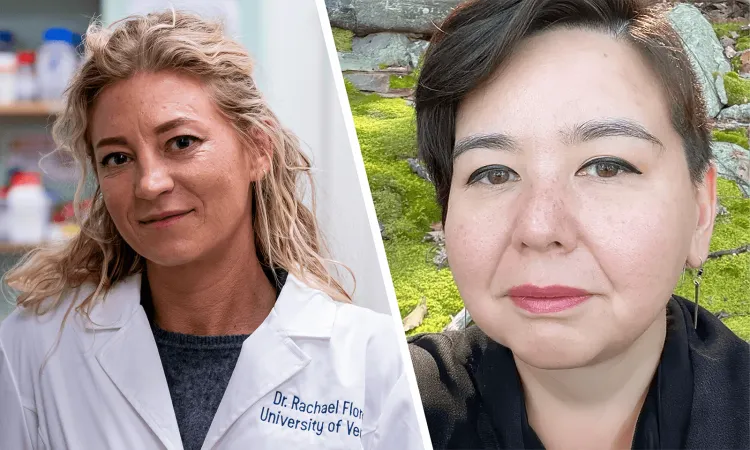That question took center stage when Science Friday, the popular national public radio program, took its show on the road to Burlington for a live conversation about “The Future of Food.” Two University of Vermont researchers — Dr. Rachael Floreani, an associate professor in the Department of Mechanical Engineering whose lab is developing lab-grown meat, and Alexis Yamashita, a doctoral student and community organizer in UVM's Food Systems Research Institute studying mung bean cultivation — joined Science Friday host Flora Lichtman at Hula on Burlington's lakefront to share how their very different projects converge around a common goal: creating sustainable, equitable, and delicious food systems for Vermont and beyond.
Engineering a More Sustainable Steak
Floreani’s path to food innovation began far from the kitchen — in orthopedic engineering.
“I started off designing hip implants,” she told the audience with a laugh. “Then one of my students came into the lab and said, ‘You know, we could use this technology to make food.’”
That idea sparked a radical shift in Floreani’s research. Today, her Engineered Biomaterials Research Laboratory (EBRL) at UVM engineers scaffolds — sponge-like structures that give lab-grown meat its texture and “mouthfeel.” The scaffolds provide a home for animal cells to grow and mature into something that looks, feels, and eventually tastes like a steak.
“It’s not just about making meat,” Floreani explained. “It’s about designing materials that mimic nature. The cells do the rest.”
Her team uses upcycled whey protein from Cabot Creamery as a key ingredient for these scaffolds — a sustainable alternative to animal-derived collagen. “We were the first to show that muscle cells can grow on whey protein,” she said. “If the scaffold is stiff, you can get bone-like tissue; if it’s soft, you can get fat. We need all of that when we talk about meat.”
While the cultivated meat industry faces challenges in scaling production, Floreani’s vision remains grounded in local impact. “For me, it’s not just about food security — it’s food access,” she said. “If we can make meatballs here in Burlington that are affordable and nutritious, imagine what we can bring to food shelves and communities that need them most.”

Growing a Local Future for Mung Beans
Across campus, Alexis Yamashita’s research is taking root in Vermont’s soil. Her work with mung beans — a small but mighty legume rich in protein and central to many Asian and African cuisines — aims to strengthen regional food resilience and cultural inclusion.
“In Vermont, many communities have mung beans at the heart of their food cultures,” she said. “But most of what’s available in the U.S. is imported. My work is about changing that — cultivating local varieties and getting them onto more plates here in Burlington.”
Yamashita and her collaborators have already trialed more than 50 varieties of mung beans across Vermont fields. The results are promising: many are thriving in the state’s climate, offering new opportunities for farmers and gardeners.
“Many of the varieties we’re working with are open-pollinated,” she explained. “That means farmers can save seed, adapt them locally, and make them stronger for our region.”
The project also centers community voices — particularly when it comes to taste. “We ask people, what makes a good mung bean?” Yamashita said. “Texture matters — soft, smooth, even creamy. When farmers and eaters guide that process, we get beans that taste amazing and belong to this place.”
Collaboration Over Competition
Although their approaches differ — one working in the lab, the other in the field — Floreani and Yamashita agree that feeding the future will require collaboration across disciplines and diets.
“There’s no rivalry between the veggie people and the meat people,” Yamashita said with a smile. “We need a diversification of solutions — embracing new technologies and honoring traditional foods.”
Floreani echoed that spirit of cooperation. “If we can welcome science and innovation into Vermont’s farming community,” she said, “we can keep talent here, create jobs, and build a food system that reflects our values.”
Both researchers embody UVM’s unique approach to solving global challenges — pairing scientific ingenuity with community engagement.
As Yamashita put it: “When we grow food that fits our climate, our culture, and our taste, the adaptation will follow. That’s how we feed the future — starting right here in Vermont.”
Listen to the complete Science Friday episode:
A complete transcript of the program is available on the Science Friday website.

